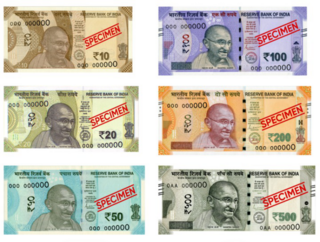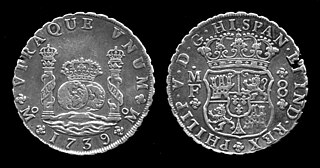This article is largely based on the article "Agio" in the out-of-copyright Encyclopædia Britannica Eleventh Edition, which was produced in 1911.(January 2016) |
Agio (Italian aggio) is a term used in commerce for exchange rate, discount or premium.
This article is largely based on the article "Agio" in the out-of-copyright Encyclopædia Britannica Eleventh Edition, which was produced in 1911.(January 2016) |
Agio (Italian aggio) is a term used in commerce for exchange rate, discount or premium.
The variations from fixed par values or rates of exchange in the currencies of different countries.[ clarification needed ] For example, in most countries that used the gold standard, the standard coin was kept up to a uniform point of fineness. In particular, a freshly minted English sovereign was in a fixed relation to freshly minted coins of other countries: 1 £ = 25.221 francs = 20.429 marks = US$4.867, etc. [1]
This rate, known as the mint par of exchange, did not necessarily coincide with the corresponding market exchange rates. The balance of trade between the countries determined the actual rate of exchange. If England has a negative balance of trade with France, for instance, currency of equal magnitude is remitted to France, which thus creates a demand for French currency. Procurement of that currency involves payment of a premium referred to as agio. It refers to exchange rate. [1]
The term was also used to denote the difference in exchange between two currencies in the same country where silver coinage was the legal tender. An agio was sometimes allowed for payment in the more convenient form of gold or where the paper currency value of a country fell below the bullion that it ostensibly represented. [1]
In the process of use, coinage deteriorates over time, and its value falls below the nominal value. To illustrate, suppose that this reduction in the value of the pound is 5%. Reflecting their nominal value, 100 sovereigns in England would be accepted as a payment in full for £100 debt. Payment of debt outside England is based, however, on the physical state of the coin. In this case each coin is valued as £0.95, and payment of £100 debt requires £100 / £0.95 = 105.26 coins thence an agio of 5.26 sovereigns. [1]
A currency is a standardization of money in any form, in use or circulation as a medium of exchange, for example banknotes and coins. A more general definition is that a currency is a system of money in common use within a specific environment over time, especially for people in a nation state. Under this definition, the British Pound sterling (£), euros (€), Japanese yen (¥), and U.S. dollars (US$) are examples of (government-issued) fiat currencies. Currencies may act as stores of value and be traded between nations in foreign exchange markets, which determine the relative values of the different currencies. Currencies in this sense are either chosen by users or decreed by governments, and each type has limited boundaries of acceptance; i.e., legal tender laws may require a particular unit of account for payments to government agencies.

A gold standard is a monetary system in which the standard economic unit of account is based on a fixed quantity of gold. The gold standard was the basis for the international monetary system from the 1870s to the early 1920s, and from the late 1920s to 1932 as well as from 1944 until 1971 when the United States unilaterally terminated convertibility of the US dollar to gold, effectively ending the Bretton Woods system. Many states nonetheless hold substantial gold reserves.

In finance, a bond is a type of security under which the issuer (debtor) owes the holder (creditor) a debt, and is obliged – depending on the terms – to provide cash flow to the creditor. The timing and the amount of cash flow provided varies, depending on the economic value that is emphasized upon, thus giving rise to different types of bonds. The interest is usually payable at fixed intervals: semiannual, annual, and less often at other periods. Thus, a bond is a form of loan or IOU. Bonds provide the borrower with external funds to finance long-term investments or, in the case of government bonds, to finance current expenditure.

The Australian dollar is the official currency and legal tender of Australia, including all of its external territories, and three independent sovereign Pacific Island states: Kiribati, Nauru, and Tuvalu. In April 2022, it was the sixth most-traded currency in the foreign exchange market and as of Q4 2023 the seventh most-held reserve currency in global reserves.

The Canadian dollar is the currency of Canada. It is abbreviated with the dollar sign $. There is no standard disambiguating form, but the abbreviations Can$, CA$ and C$ are frequently used for distinction from other dollar-denominated currencies. It is divided into 100 cents (¢).

Legal tender is a form of money that courts of law are required to recognize as satisfactory payment for any monetary debt. Each jurisdiction determines what is legal tender, but essentially it is anything which when offered ("tendered") in payment of a debt extinguishes the debt. There is no obligation on the creditor to accept the tendered payment, but the act of tendering the payment in legal tender discharges the debt.

Sterling is the currency of the United Kingdom and nine of its associated territories. The pound is the main unit of sterling, and the word pound is also used to refer to the British currency generally, often qualified in international contexts as the British pound or the pound sterling.

The mark was a currency or unit of account in many states. It is named for the mark unit of weight. The word mark comes from a merging of three Germanic words, Latinised in 9th-century post-classical Latin as marca, marcha, marha or marcus. It was a measure of weight mainly for gold and silver, commonly used throughout Europe and often equivalent to 8 troy ounces (250 g). Considerable variations, however, occurred throughout the Middle Ages.

The franc, also commonly distinguished as the French franc (FF), was a currency of France. Between 1360 and 1641, it was the name of coins worth 1 livre tournois and it remained in common parlance as a term for this amount of money. It was reintroduced in 1795. After two centuries of inflation, it was redenominated in 1960, with each new franc (NF) being worth 100 old francs. The NF designation was continued for a few years before the currency returned to being simply the franc. Many French residents, though, continued to quote prices of especially expensive items in terms of the old franc, up to and even after the introduction of the euro in 2002. The French franc was a commonly held international reserve currency of reference in the 19th and 20th centuries. Between 1998 and 2002, the conversion of francs to euros was carried out at a rate of 6.55957 francs to 1 euro.

The Indian rupee is the official currency in India. The rupee is subdivided into 100 paise. The issuance of the currency is controlled by the Reserve Bank of India. The Reserve Bank manages currency in India and derives its role in currency management based on the Reserve Bank of India Act, 1934.

The pound was the currency of Australia from 1910 until 14 February 1966, when it was replaced by the Australian dollar. Like other £sd currencies, it was subdivided into 20 shillings, each of 12 pence.

The German mark was the currency of the German Empire, which spanned from 1871 to 1918. The mark was paired with the minor unit of the pfennig (₰); 100 pfennigs were equivalent to 1 mark. The mark was on the gold standard from 1871 to 1914, but like most nations during World War I, the German Empire removed the gold backing in August 1914, and gold coins ceased to circulate.

The silver standard is a monetary system in which the standard economic unit of account is a fixed weight of silver. Silver was far more widespread than gold as the monetary standard worldwide, from the Sumerians c. 3000 BC until 1873. Following the discovery in the 16th century of large deposits of silver at the Cerro Rico in Potosí, Bolivia, an international silver standard came into existence in conjunction with the Spanish pieces of eight. These silver dollar coins played the role of an international trading currency for nearly four hundred years.

The history of the rupee traces back to ancient times in the Indian subcontinent. The mention of rūpya by Pāṇini is seemingly the earliest reference in a text about coins. The term in Indian subcontinent was used for referring to a coin.

The history of Canadian currencies began with Indigenous peoples in Canada prior to European contact, when they used items such as wampum and furs for trading purposes. The Indigenous peoples continued to use those items as currency when trade with Europeans began. During the period of French colonization, coins were introduced, as well as one of the first examples of paper currency by a western government. During the period of British colonization, additional coinage was introduced, as well as banknotes. The Canadian colonies gradually moved away from the British pound and adopted currencies linked to the United States dollar. With Confederation in 1867, the Canadian dollar was established. By the mid-20th century, the Bank of Canada was the sole issuer of paper currency, and banks ceased to issue banknotes.

Money is any item or verifiable record that is generally accepted as payment for goods and services and repayment of debts, such as taxes, in a particular country or socio-economic context. The primary functions which distinguish money are: medium of exchange, a unit of account, a store of value and sometimes, a standard of deferred payment.

The United States dollar is the official currency of the United States and several other countries. The Coinage Act of 1792 introduced the U.S. dollar at par with the Spanish silver dollar, divided it into 100 cents, and authorized the minting of coins denominated in dollars and cents. U.S. banknotes are issued in the form of Federal Reserve Notes, popularly called greenbacks due to their predominantly green color.

Fiat money is a type of currency that is not backed by a precious metal, such as gold or silver, or backed by any other tangible asset or commodity. Fiat currency is typically designated by the issuing government to be legal tender, and is authorized by government regulation. Since the end of the Bretton Woods system in 1971, the major currencies in the world are fiat money.
British involvement in the Middle East began with the General Maritime Treaty of 1820. This established the Trucial States and the nearby island of Bahrain as a base for suppressing sea piracy in the Persian Gulf. Meanwhile, in 1839 the British East India Company established an anti-piracy station in Aden to protect British shipping that was sailing to and from India. Involvement in the region expanded to Egypt in 1875 because of British interests in the Suez Canal, with a full scale British invasion of Egypt taking place in 1882. Muscat and Oman became a British Protectorate in 1891, and meanwhile Kuwait was added to the British Empire in 1899 because of fears surrounding the proposed Berlin-Baghdad Railway. There was a growing concern in the United Kingdom that Germany was a rising power, and about the implications that the proposed railway would have as regards access to the Persian Gulf. Qatar became a British Protectorate in 1916, and after the First World War, the British influence in the Middle East reached its fullest extent with the inclusion of Palestine, Transjordan and Iraq.
Prior to European colonization, early Aboriginal Australian communities traded using items such as tools, food, ochres, shells, raw materials and stories, although there is no evidence of the use of currencies.